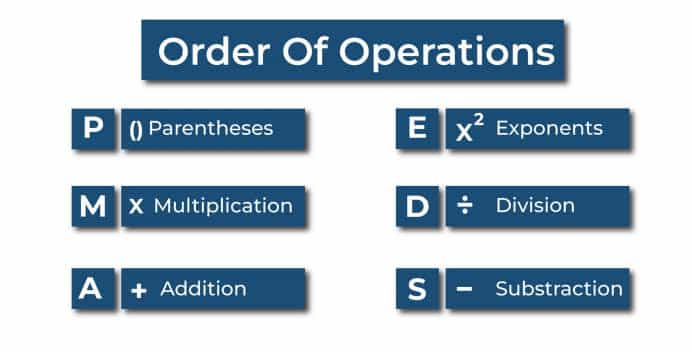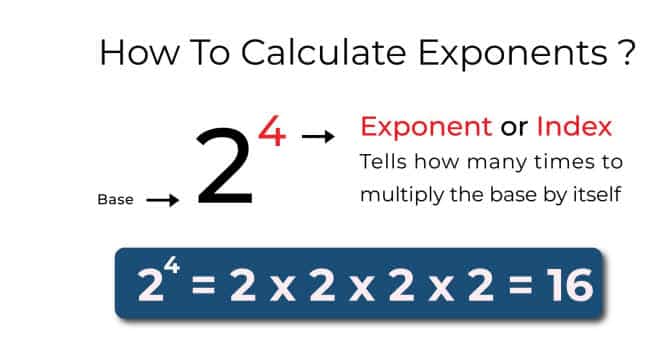Order of Operations
Grade 6 Math Worksheets
The order of operations is the set of rules that defines the order in which calculations must be carried out in a mathematical expression. The order of operations is important because it determines how calculations are performed, which can affect the result.
In this article, we will cover:
- The Standard Order of Operations
- Parentheses
- Exponents
- Multiplication and Division
- Addition and Subtraction
- Order of Operations Solved Examples
- Order of Operations Practice Problems
- FAQs
Personalized Online Tutoring
Order of Operations - Grade 6 Math Worksheet PDF
This is a free printable / downloadable PDF worksheet with practice problems and answers. You can also work on it online.
Sign up with your email ID to access this free worksheet.
"We really love eTutorWorld!"
"We really love etutorworld!. Anand S and Pooja are excellent math teachers and are quick to respond with requests to tutor on any math topic!" - Kieran Y (via TrustSpot.io)
"My daughter gets distracted easily"
"My daughter gets distracted very easily and Ms. Medini and other teachers were patient with her and redirected her back to the courses.
With the help of Etutorworld, my daughter has been now selected in the Gifted and Talented Program for the school district"
- Nivea Sharma (via TrustSpot.io)
The standard order of operations is as follows:
- Perform any calculations inside parentheses or brackets first.
- Perform any calculations involving exponents or radicals.
- Perform any multiplications and divisions, working from left to right.
- Perform any additions and subtractions, working from left to right.
Using parentheses to specify the order in which calculations should be performed is a good idea, especially when working with more complex expressions.

The acronym PEMDAS, which stands for Parentheses, Exponents, Multiplication and Division, Addition and Subtraction, is often used to help remember the order of operations. The acronym PEMDAS is also used and is the same as PEMDAS, just with the M and D switched. It is essential to use the correct order of operations when evaluating mathematical expressions to ensure that the correct result is obtained.
Parentheses
In the order of operations, calculations inside parentheses or brackets are performed first. This is because parentheses and brackets are used to group calculations that should be done before any other functions in the expression.
For example, consider the following expression:

Without any parentheses, it is not clear what should be calculated first. Should the multiplication be done before the addition or the other way around? To specify the order in which the calculations should be performed, we can use parentheses:

In this case, the expression inside the parentheses, 4 + 3, is calculated first, giving a result of 7. Then the multiplication is performed, showing a final result of 35 – 2, or 33.
Using parentheses correctly in an expression is essential to ensure that the intended order of operations is followed and the correct result is obtained.
Another example to show that groupings inside should be solved first.

Step 1: In this case, the expression inside the parentheses (32 ÷ 4) should be calculated first. So it will be 8.
Step 2: Now the expression inside the square parentheses [8 + 3] should be solved. So, it will be 11.
Step 3: Then the multiplication is performed, showing a final result of 11 × 2 = 22.
Exponents
In the order of operations, calculations involving exponents, also known as powers or indices, are performed before any multiplications or divisions. This is because exponents indicate the number of times a number should be multiplied by itself, and these calculations should be done before any other operations (except parentheses) in the expression.
An exponent is a small number written above and to the right of another number, called the base. The exponent tells you how many times to multiply the base by itself. For example, the base 4 and exponent 3 can be written like this: 4^3. This means to multiply 4 by itself 3 times, or 4*4*4. The result is 64.

For example, consider the following expression:
2 + 3 * 4^2
In this case, the exponent, 4^2, indicates that 4 should be multiplied by itself 2 times, or 4*4, which gives a result of 16. The exponent calculation is done before the multiplication, so the outcome of the expression is 2 + 3 * 16, or 2 + 48, or 50.
Multiplication and Division
In the order of operations, multiplication and division are performed before addition and subtraction. This is because multiplications and divisions are considered equal priorities and should be performed before any additions or subtractions.
For example, consider the following expression:
2 + 4 * 3 – 6 / 2
In this case, multiplication and division should be performed before the additions and subtractions. First, the multiplication is done: 4 * 3 = 12. Then the division is done: 6 / 2 = 3. Finally, the additions and subtractions are made: 2 + 12 – 3 = 11.
Here is another example:
5 – 4 / 2 + 8 * 3
In this case, the division and multiplication should be done first: 4 / 2 = 2 and 8 * 3 = 24. Then the additions and subtractions are done: 5 – 2 + 24 = 27.
Addition and Subtraction
In the order of operations, additions and subtractions are the final calculations that should be performed. This is because they are considered an equal priority and should be performed after all other calculations have been completed.
For example, consider the following expression:
2 + 4 * 3 – 6 / 2
In this case, multiplication and division should be performed before the additions and subtractions. First, the expansion is done: 4 * 3 = 12. Then the division is done: 6 / 2 = 3. Finally, the additions and subtractions are made: 2 + 12 – 3 = 11.
Here is another example:
5 – 4 / 2 + 8 * 3
In this case, the division and multiplication should be done first: 4 / 2 = 2 and 8 * 3 = 24. Then the additions and subtractions are done: 5 – 2 + 24 = 27.
“There have been times when we booked them last minute, but the teachers have been extremely well-prepared and the help desk at etutorworld is very prompt.
Our kid is doing much better with a higher score.”
6th Grade Tutoring
eTutorWorld offers Personalized Online Tutoring for Math, Science, English, and Standardised Tests.
Our Tutoring Packs start at just under $22.49 per hour, and come with a moneyback guarantee.
Schedule a FREE Trial Session, and experience quality tutoring for yourself. (No credit card required.)
Order of Operations Solved Examples:
Example 1: Solve: 2 + 6 × (4 + 5) ÷ 3 – 5 using PEMDAS.
Solution:
Step 1 – Parentheses : 2+6 × (4 + 5) ÷ 3 – 5 = 2 + 6 × 9 ÷ 3 – 5
Step 2 – Multiplication: 2 + 6 × 9 ÷ 3 – 5 = 2 + 54 ÷ 3 – 5
Step 3 – Division: 2 + 54 ÷ 3 – 5 = 2 + 18 – 5
Step 4 – Addition: 2 + 18 – 5 = 20 – 5
Step 5 – Subtraction: 20 – 5 = 15
Order of Operations Practice Problems:
- Solve 100 ÷ (6 + 7 × 2) – 5 using PEMDAS.
- Solve 600 ÷ (44 + 14 × 4) – 5 using PEMDAS.
Do You Stack Up Against the Best?
If you have 30 minutes, try our free diagnostics test and assess your skills.
Order of Operations FAQS
What does PEMDAS stand for?
PEMDAS stands for Parentheses, Exponents, Multiplication, Division, and Addition and Subtraction. This acronym is used to help remember the order of operations in mathematics.
What is the order of operations in PEMDAS?
The order of operations in PEMDAS is as follows: Parentheses first, then Exponents, then Multiplication and Division (performed left to right), and finally Addition and Subtraction (performed left to right).
Why is the order of operations important?
The order of operations is important because it determines the order in which calculations are performed, which can affect the result. It is essential to use the correct order of operations to ensure that the correct result is obtained.
What is the meaning of the acronym PEMDAS?
The acronym PEMDAS stands for Parentheses, Exponents, Multiplication and Division, and Addition and Subtraction. These terms represent the order in which calculations should be performed in a mathematical expression.

Gloria Mathew writes on math topics for K-12. A trained writer and communicator, she makes math accessible and understandable to students at all levels. Her ability to explain complex math concepts with easy to understand examples helps students master math. LinkedIn
Affordable Tutoring Now Starts at Just $22.49
eTutorWorld offers affordable one-on-one live tutoring over the web for Grades K-12. We are also a leading provider of Test Prep help for Standardized Tests (SCAT, CogAT, MAP, SSAT, SAT, ACT, ISEE, and AP).
What makes eTutorWorld stand apart are: flexibility in lesson scheduling, quality of hand-picked tutors, assignment of tutors based on academic counseling and diagnostic tests of each student, and our 100% money-back guarantee.
Whether you have never tried personalized online tutoring before or are looking for better tutors and flexibility at an affordable price point, schedule a FREE TRIAL Session with us today.
*There is no purchase obligation or credit card requirement
Grade 6 Science Worksheets
- Inquiry process
- Nature of Science
- Scientific Inquiry
- Inquiry, Analysis and Problem Solving
- Ethical Practices
- Science and Society
- Biotic and Abiotic Factors
- Impact of Organisms
- Adaptation
- Spheres of Earth
- Natural Resources
- Environmental Issues
- Conservation of Earth
- Understanding Technology
- Abilities To Do Technological Design
- Structure of Earth
- Solar System
- Rocks and Fossils
- Earth Systems
- Plate Tectonics
- Evolution
- Magnetic Field of Earth
- Geologic Time
- Materials and Processes That Shape a Planet
- Astronomy
- Ecology
- Energy
- Kinetic and Potential Energy
- Energy Transfer
- Matter and its Structure
- States of Matter
- Physical and Chemical Changes
- Force and Motion
- Electricity and Magnetism
- Wave Interactions
- Sound
- Light
- Introduction to Life Science
- The Origin & History of Life On Earth
- Plant and Animal Cells
- Parts of a Cell
- The Cell Cycle
- How Living Organisms Get Energy
- Classification of Organisms
- How Plants Grow & Reproduce
- The Human Respiratory System
- The Human Cardiovascular System
- The Human Digestive System
- The Human Endocrine Systems
- The Human Nervous System
- The Human Muscular System
- The Human Skeletal System
IN THE NEWS

Our mission is to provide high quality online tutoring services, using state of the art Internet technology, to school students worldwide.
Online test prep and practice
SCAT
SSAT
ISEE
PSAT
SAT
ACT
AP Exam
Science Tutoring
Physics Tutoring
Chemistry Tutoring
Biology Tutoring
Math Tutoring
Pre-Algebra Tutoring
Algebra Tutoring
Pre Calculus Tutoring
Calculus Tutoring
Geometry Tutoring
Trigonometry Tutoring
Statistics Tutoring
Quick links
Free Worksheets
Fact sheet
Sales Partner Opportunities
Parents
Passive Fundraising
Virtual Fundraising
Our Expert Tutors
Safe and Secure Tutoring
Interactive Online Tutoring
After School Tutoring
Elementary School Tutoring
Middle School Tutoring
High School Tutoring
Home Work Help
Math Tutors New York City
Press
©2022 eTutorWorld Terms of use Privacy Policy Site by Little Red Bird
©2022 eTutorWorld
Terms of use
Privacy Policy
Site by Little Red Bird









